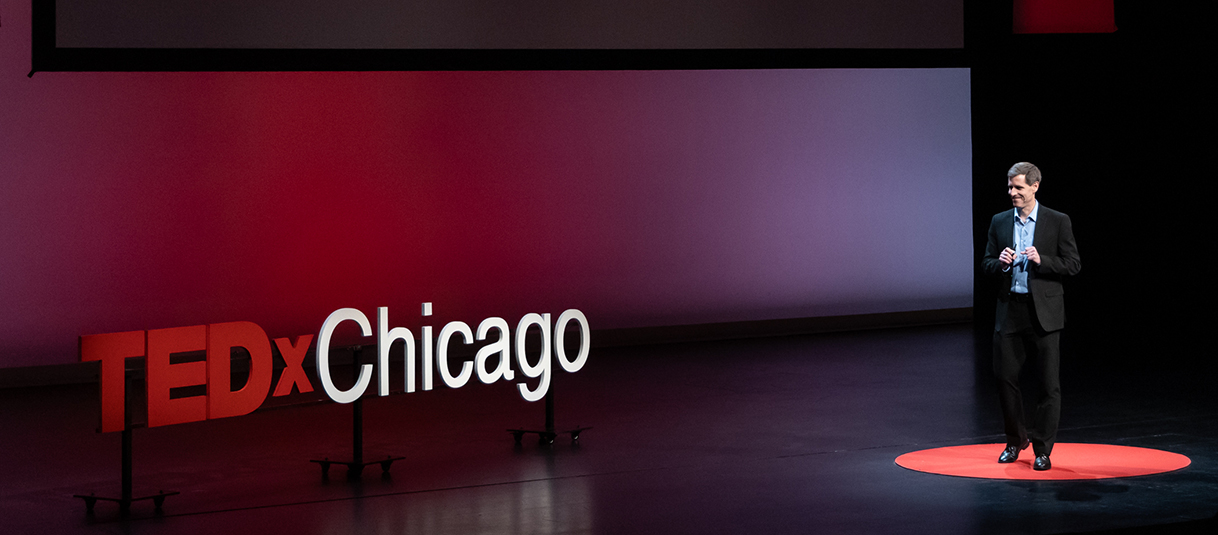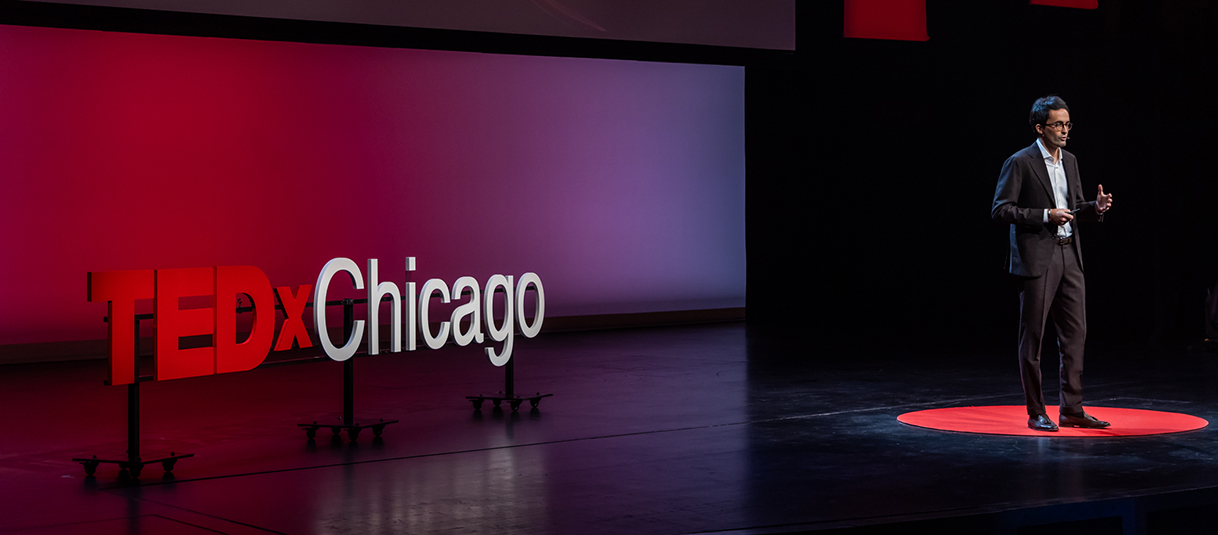Mark Hersam and Alessandro Rotta Loria Spotlight Sustainable AI, Urban Climate Solutions at TEDxChicago
The two Northwestern Engineering faculty members spoke at the September 27 event
Local TEDx events bring together area thought leaders to spread their knowledge and inspire audiences.
At TEDxChicago 2024, two Northwestern Engineering professors had the chance to present their work fighting some of the world’s biggest problems.
Mark C. Hersam and Alessandro Rotta Loria presented at this year’s TEDxChicago, an independently organized TED event that promotes “ideas worth spreading.” Organized around the theme of “Lighting the Way,” the event took place September 27 at the Harris Theater for Music and Dance in Chicago.
Other speakers at this year’s TEDxChicago included community food systems developer Erika Allen, architect Carol Ross Barney, healthcare architect Abbie Clary, art engineer Vanessa Harris, accelerator physicist Lia Merminga, supercomputer scientist Michael Papka, and artist Scheherazade Tillet.
Hersam, Walter P. Murphy Professor of Materials Science and Engineering, spoke about sustainable artificial intelligence (AI). Rotta Loria, Louis Berger Junior Associate Professor of Civil and Environmental Engineering, presented on urban climate solutions.
A sustainable AI future
AI influence in our daily lives is growing rapidly. The benefits and drawbacks of the technology are seemingly discussed at the same rate.
Hersam mentioned another AI challenge that might be overlooked but needs to be addressed.
“For me personally, what keeps me up late at night, what keeps my team at Northwestern University working long hours in the lab, is a threat that is even greater [than others presented by AI],” Hersam said. “That threat is energy consumption.”
By 2027, Hersam said, AI will consume 100 trillion-watt hours of electricity annually – the equivalent amount of electricity used by a country the size of Argentina. The AI energy demands are so great that Microsoft has hired nuclear engineers who are “seriously contemplating” building dedicated reactors to power each of their AI data centers.
The problem does not end there, as Hersam pointed out. All that anticipated energy generates immense amounts of heat, which will need to be cooled by approximately 200 billion gallons water in a world where 2.7 billion people live with water scarcity.
Hersam and his lab are working on finding a solution.
“As a nanotechnologist for the last 25 years, I strongly believe that by understanding matter at the shortest of length-scales, we can find solutions to the world’s largest problems,” said Hersam, who directs Northwestern’s Materials Research Center and chairs the Department of Materials Science and Engineering.

Using nanotechnology, Hersam and his teammates are working on producing an alternative hardware platform for AI that will be more energy-efficient than a standard computer. Today, every computer is based on an architecture originally proposed by John von Neumann, which consists of a spatially separated memory unit and central processing unit. The movement of the large quantities of data required for AI between these two units leads to significant energy consumption.
To avoid the need for dedicated power plants for AI data centers, the von Neumann architecture needs to be reconsidered. Hersam’s lab is looking to biology for inspiration, trying to mimic the brain for next-generation computing.
This neuromorphic (i.e., brain-like) computing has the potential to replicate the brain’s energy-efficiency as a pathway to make AI less energy dependent. In the brain, memory and information processing are co-located, minimizing the need to move data, thereby avoiding the main source of energy consumption in the von Neumann architecture. The brain is also dynamic, reconfigurable, and highly interconnected, all of which further contribute to its high energy-efficiency.
Hersam told the audience why he is turning to nanomaterials to emulate the desirable attributes of the brain in next-generation computer hardware. With dimensions approaching atomic length scales, the properties of nanomaterials can be tuned with electric fields, thus mimicking the dynamic reconfigurability of the brain. Capitalizing on this technology, Hersam’s lab has developed nanoelectronic devices that can perform AI-based machine learning with 100-fold lower energy consumption than conventional computing.
Despite these advances, Hersam acknowledged that his current devices are only capable of “the most rudimentary” form of AI. Eventually, achieving “sophisticated AI” that can emulate cognitive function is the goal.
Getting there requires interdisciplinary collaboration, which is a hallmark of Northwestern and the McCormick School of Engineering. From his interdisciplinary work with colleagues in neurobiology, Hersam has recognized the high degree of heterogeneity in the brain that starkly contrasts with silicon electronics where the exact same device (i.e., the transistor) is replicated billions of times in integrated circuits.
“For bio-realistic neuromorphic computing, we do not want to have billions of the same device. Instead, we want to have many different devices that can be dynamically reconfigured on demand,” Hersam said. “Our nanoelectronic devices are the foundation of that future.”
Hersam did not put a specific timeline on when neuromorphic computing will move from university prototypes to large-scale deployment in AI data centers, but he was optimistic that day is coming soon.
“Nanotechnology is evolving rapidly and in a way that can be commercially scaled,” Hersam said. “Therefore, I am optimistic that energy-efficient AI can be delivered in time, particularly before we run into the most nefarious consequences of conventional AI.”
Using underground heat to combat climate change
Though the ground beneath us seems still and calm, the opposite is true. That ground is deforming in many cities around the globe, Rotta Loria told the audience.
Inspired by Dante Alighieri’s description of Hell in “The Divine Comedy,” Rotta Loria’s work focuses on the subsurface. Like Dante, other civilizations considered the subsurface a place devoid of good.
Rotta Loria does not see it that way. In prehistoric times, caves were built underground to protect humans from threats. Today, the underground is used for intricate infrastructure projects that support our society, such as parking garages and tunnels.
Those structures produce heat, warming the underground. In cities such as London, New York, and Chicago, underground train stations can experience extreme heat. That heat also spreads and leaks into the ground, creating subsurface urban heat islands - an underground climate change.
Underground climate change presents myriad problems. It is a health issue for commuters who can suffer heat-related illnesses. It also causes infrastructure and machinery – such as trains – to age more quickly and break down sooner. Underground climate change can also affect subsurface ecosystems.

Rotta Loria’s focuses on another consequence of the phenomenon: deformations in the rocks and soils caused by the increased heat could jeopardize the durability and integrity of the infrastructure supporting our cities. In a study published last year, Rotta Loria demonstrated how underground climate change led to shifting ground beneath urban areas, causing building foundations and the surrounding ground to move excessively and even crack, which ultimately affects structures’ long-term operational performance and durability.
“The problem is that none of our buildings were designed to handle [the deformations]. More importantly, these deformations can be large enough that they can affect the durability of the civil infrastructure supporting our cities,” Rotta Loria said. “Cities need to act fast to mitigate underground climate change.”
Rotta Loria shared his idea for how that can be accomplished.
The urban underground contains massive amounts of waste heat and geothermal heat, the latter being the most abundant renewable resource we have other than solar energy. The urban surface, meanwhile, presents tremendous thermal-energy needs in buildings.
Rotta Loria told the audience about the potential to transfer heat from the subsurface to the surface. That would mitigate two issues: lessening the underground climate change while meeting the energy needs in buildings.
“The exciting thing is that we can do this today, not tomorrow,” said Rotta Loria, who directs the Subsurface Opportunities and Innovations Laboratory at Northwestern Engineering.
For decades, geoexchange systems have consisted of holes drilled into the ground that integrate plastic pipes with heated water meant to circulate heat for applications such as space heating and cooling, and hot water production.
While the traditional method is an option to mitigate underground climate change and meet energy needs, Rotta Loria’s research over the last decade has contributed to establishing an alternative: geothermal structures (also called energy geostructures). Applicable to both new and existing constructions thanks to research and inventions led by the Rotta Loria, these energy geostructures essentially represent any kind of underground construction transformed into a source of clean thermal energy.
“By exchanging heat with the ground surrounding these underground spaces, and/or the air circulating in these underground spaces, this technology forms a closed-loop circuit working with heat pumps, with the ultimate aim to provide renewable heating and cooling to any building you can think of,” Rotta Loria said. “At the same time, this technology promises to decarbonize entire urban communities.”
Past TedX Talks from McCormick
Hersam and Rotta Loria are the latest members of the Northwestern Engineering community to give a TEDx talk. In September, Sheila Gujrathi (’92, MD ’96) spoke at TEDxSanDiegoWomen. Shana O. Kelley, Neena B. Schwartz Professor of Chemistry and Biomedical Engineering, gave a talk at TedxChicago 2023. At the 2022 Chicago event, a lecture was delivered by Manijeh Razeghi, Walter P. Murphy Professor of Electrical and Computer Engineering.